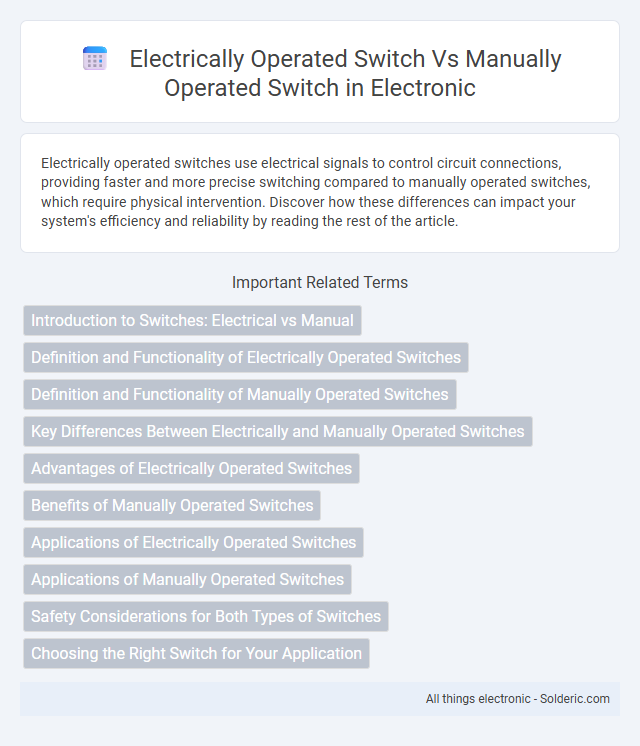Electrically operated switches use electrical signals to control circuit connections, providing faster and more precise switching compared to manually operated switches, which require physical intervention. Discover how these differences can impact your system's efficiency and reliability by reading the rest of the article.
Comparison Table
| Feature | Electrically Operated Switch | Manually Operated Switch |
|---|---|---|
| Operation | Controlled electronically via signals | Controlled by direct human action |
| Speed | Instant or programmable switching | Depends on user response time |
| Automation | Supports automation and remote control | No automation; manual intervention required |
| Reliability | High, if well-maintained and powered | Variable; subject to human error |
| Power Source | Requires electrical power supply | No external power needed |
| Application | Industrial systems, remote operations | Simple circuits, direct control situations |
| Cost | Higher initial cost and maintenance | Lower initial and maintenance cost |
Introduction to Switches: Electrical vs Manual
Electrically operated switches use electromagnetic mechanisms or motors to control circuits remotely or automatically, enabling integration with smart systems and automation technology. Manually operated switches require physical human intervention to open or close electrical circuits, making them simpler but less versatile in complex applications. Electrical switches offer faster response times and can handle higher loads, whereas manual switches are typically favored for basic, low-cost, and easily maintainable installations.
Definition and Functionality of Electrically Operated Switches
Electrically operated switches utilize electric signals to control the opening and closing of circuits, enabling automated or remote operation without physical contact. These switches function through electromagnetic mechanisms such as relays or contactors, ensuring reliable and precise control in complex electrical systems. Your choice of an electrically operated switch enhances efficiency and safety by allowing seamless integration with control systems and automated processes.
Definition and Functionality of Manually Operated Switches
Manually operated switches are electrical devices that require physical intervention to open or close circuits, controlling the flow of electricity by hand. These switches function by mechanically connecting or disconnecting electrical contacts, enabling users to start or stop electrical current manually. Common types include toggle, push-button, and rotary switches, widely used in household and industrial applications for on/off control and circuit selection.
Key Differences Between Electrically and Manually Operated Switches
Electrically operated switches function through electrical signals or remote control mechanisms, enabling automation and integration in complex systems, whereas manually operated switches require physical manipulation to toggle the circuit state. Key differences include response speed, with electrical switches providing faster actuation, and convenience, as electrically operated switches can be controlled from a distance or integrated into smart home systems. Your choice depends on application needs, where electrically operated switches excel in automation and remote operation, while manual switches remain reliable for simplicity and direct control.
Advantages of Electrically Operated Switches
Electrically operated switches offer significant advantages, including remote control capabilities, enabling you to operate devices without physical presence, which enhances convenience and safety. These switches provide faster response times and greater precision, making them ideal for automation and complex systems. Their ability to integrate with smart technologies allows for improved energy efficiency and real-time monitoring.
Benefits of Manually Operated Switches
Manually operated switches provide reliable control without dependency on power sources, ensuring operation during electrical failures or outages. Your ability to physically interact with these switches allows for precise, immediate control and enhances safety in emergency situations. Their simple design also reduces maintenance costs and increases durability compared to electrically operated switches.
Applications of Electrically Operated Switches
Electrically operated switches are widely used in industrial automation, HVAC systems, and smart home devices due to their ability to be controlled remotely and integrated with electronic control systems. These switches offer precise operation in applications requiring quick response times and the handling of high voltage or current loads that manual switches may not safely support. Your choice of an electrically operated switch enhances efficiency, safety, and convenience in complex electrical circuits and automated processes.
Applications of Manually Operated Switches
Manually operated switches are extensively used in applications requiring direct human intervention for control, such as lighting systems, household appliances, and simple machinery. These switches are favored for their simplicity, reliability, and ease of use in environments with low automation requirements. Common examples include toggle switches in residential lighting, push-button switches on industrial control panels, and rotary switches in audio equipment.
Safety Considerations for Both Types of Switches
Electrically operated switches offer enhanced safety by enabling remote operation, reducing the risk of electric shock and physical injury, particularly in hazardous environments. Manually operated switches require direct human interaction, increasing exposure to electrical faults and mechanical hazards if proper insulation and safeguards are not maintained. Both types benefit from robust design standards, such as circuit breakers and protective enclosures, which mitigate risks associated with electrical faults and ensure compliance with safety regulations.
Choosing the Right Switch for Your Application
Electrically operated switches provide rapid, remote, and automated control ideal for complex systems requiring precise timing or integration with smart technology. Manually operated switches offer simplicity, reliability, and easy maintenance, making them suitable for straightforward applications where human intervention is preferred. Your choice depends on factors like operational speed, control complexity, and environmental conditions to ensure optimal performance and safety.
electrically operated switch vs manually operated switch Infographic

 solderic.com
solderic.com